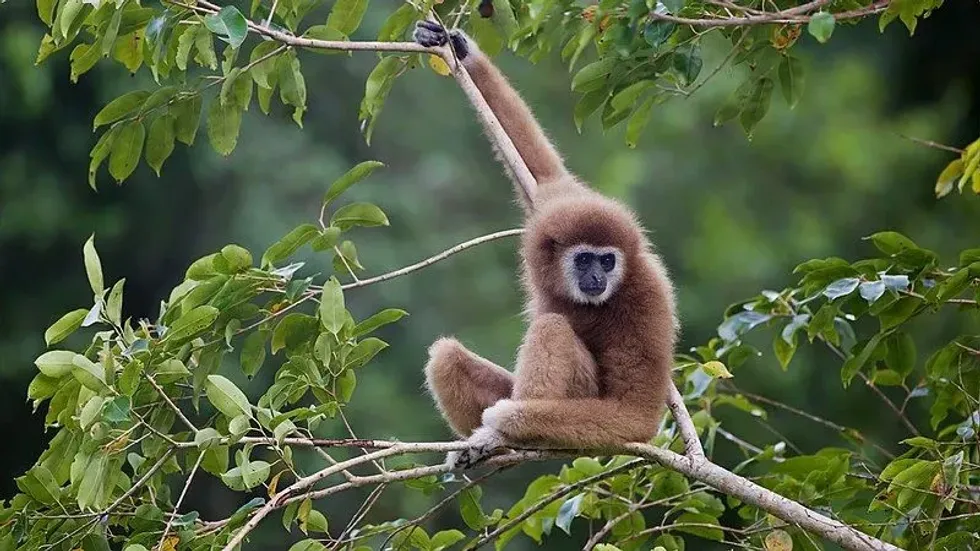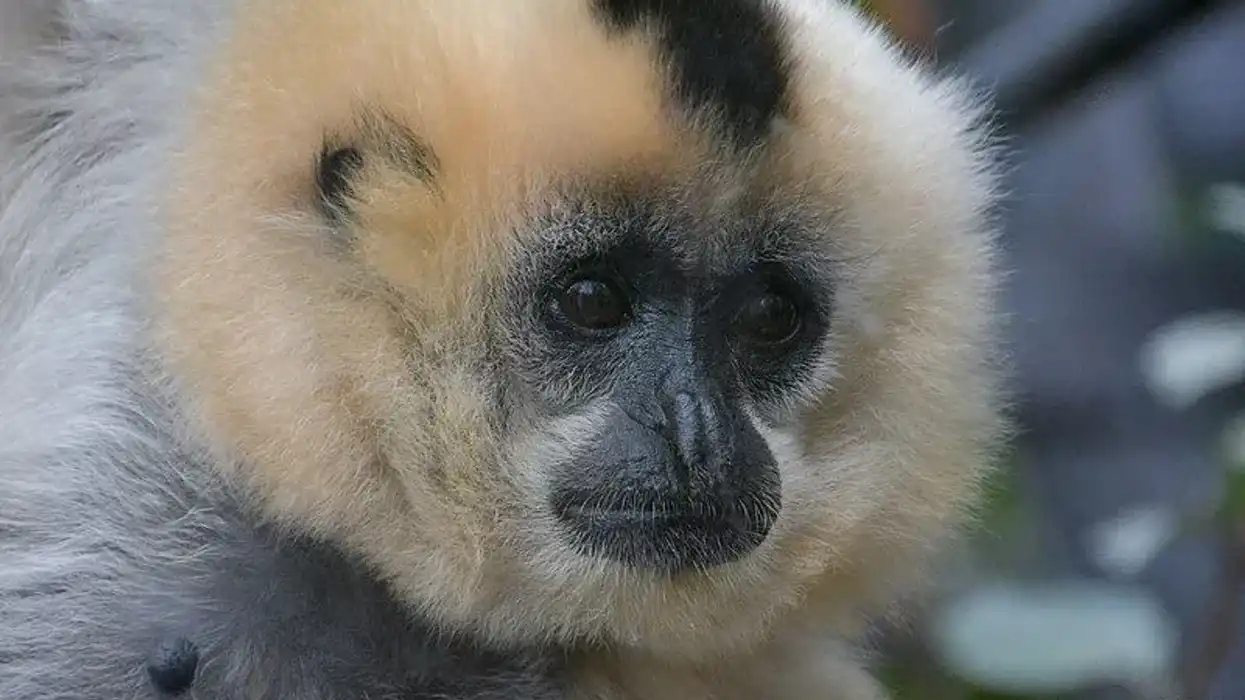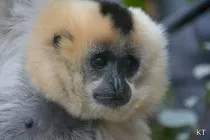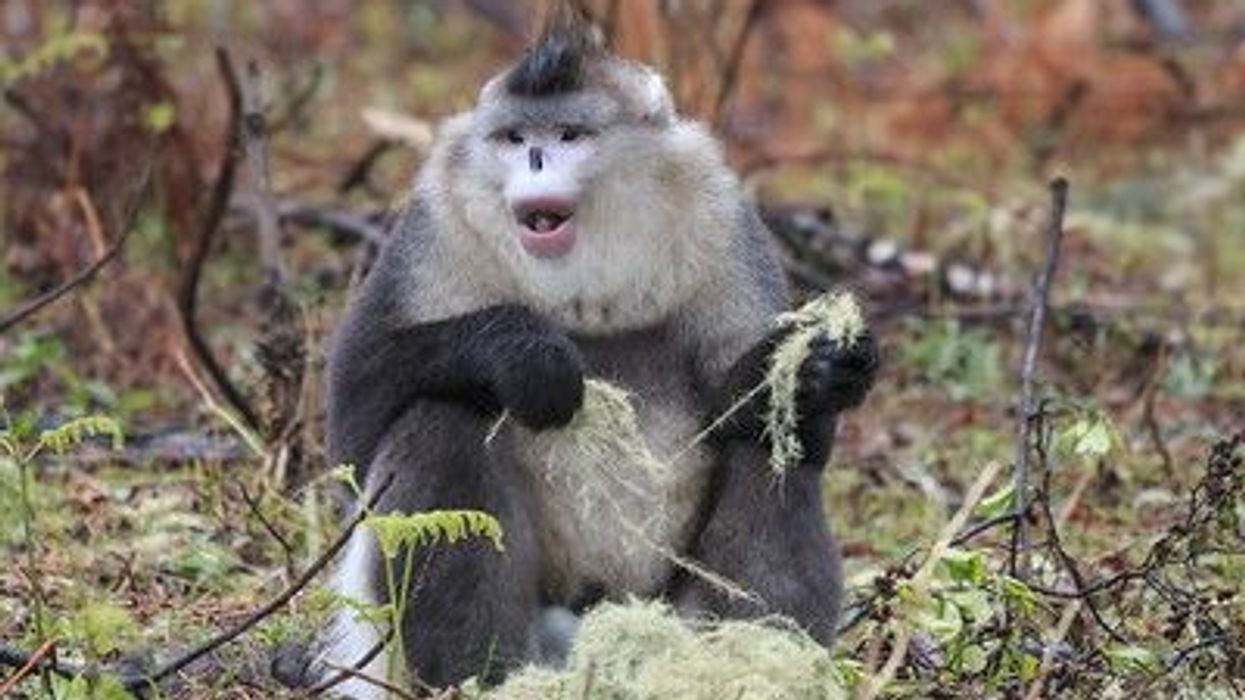Fun Hainan Gibbon Facts For Kids

The Hainan gibbon (Nomascus hainanus) or the Hainan black crested gibbon is a gibbon species that finds its native land in the Bewangling National Nature Reserve.
This reserve is situated on the Hainan Island in the South China Sea, and provides considerable forest cover to the world's rarest primate. They are considered to be lesser apes because they are of a considerably smaller size than the apes that we are most familiar with, such as gorillas.
What classifies them as an ape is the fact that Hainan gibbons do not have tails.
This gibbon species are reported to show sexual dichromatism which means that male and female Hainan gibbons differ in terms of the color of their coat. The male Hainan gibbon has a black fur coat, while the female has a golden or buff-colored coat. The two sexes can easily be distinguished by their size and their song as well.
This species is very social and loves to be in a group, which is called a family. A family, in the small population of Hainan gibbons that remains, would typically consist of an alpha male, few females, and the off-springs. The families, therefore, are polygynous.
The conservation status of the Hainan gibbon is said to be Critically Endangered, and conservation efforts are being made in order to make sure that this endangered species is not lost while making sure that no external breeding is performed.
If you enjoy reading about monkeys and apes, you don't want to miss out on the langur monkey and vervet monkey.
Hainan Gibbon Interesting Facts
What type of animal is a Hainan gibbon?
The Hainan gibbon or Hainan black-crested gibbon is a primate that is found exclusively in the Hainan Island.
What class of animal does a Hainan gibbon belong to?
Nomascus hainanus, as a species, belongs to the class of mammals, like other apes such as gorillas and chimpanzees.
How many Hainan gibbons are there in the world?
The Hainan gibbon population faced a serious decline in the 21st century, to the point that their conservation status was declared as Critically Endangered. To be exact, there are only about 28 Hainan gibbons in the world today and all the population is constricted to the Bewangling National Nature Reserve in the Hainan Island.
Therefore, it is highly unlikely that you will ever spot one of these beautiful apes.
Where does a Hainan gibbon live?
The Hainan gibbon is an arboreal variety of primates. This means that they are always to be found on trees, whether for sleeping, mating, or eating.
What is a Hainan gibbon's habitat?
The Hainan gibbon is the world's rarest primate and so, their entire population is limited to the Bewangling National Nature Reserve in the Hainan Island in the South China Sea. Conservation efforts are being implemented to protect these apes.
Who do Hainan gibbons live with?
These beautiful primates are most fond of having large social groups. They are usually found in a group of four to five, which is called a family. There is usually just one alpha male in the group along with many females and their off-springs. These groups are polygynous.
There are isolated events where you might be able to spot a solitary gibbon which is typically understood to be a consequence of the declining population.
How long does a Hainan gibbon live?
While the exact lifespan of Hainan gibbons is not known, a gibbon's lifespan range can be up to 60 years. It is safe to assume that the lifespan of Hainan gibbons would be of around 55-60 years too.
How do they reproduce?
The Hainan gibbon (Nomascus hainanus) is known to be a species of mammals which means that their reproduction habits are similar to those of humans.
The male Hainan gibbon mates with the female after the male initiates the process through various gestures swinging on one arm. The gestational period is of around 24-25 weeks and a single offspring is born typically in the ripening season, so that both the mother and child have ample to feed on.
The baby Hainan gibbon depends on its mother for food and protection until it reaches about one and a half years of age.
At the age of about nine, these gibbons reach sexual maturity and the males can begin breeding females.
What is their conservation status?
According to the IUCN, the population of Hainan gibbons is Critically Endangered which means that their habitat is steadily declining. The total population of these marvellous creatures has come down to about 28 in recent years.
The decline in their numbers was due to the massive population blast that took place in China which caused the gibbon habitat to be degraded in order to accommodate more people. Since their population has declined so quickly and it is mostly due to man made reasons, it is our responsibility to protect them from extinction.
Hainan Gibbon Fun Facts
What do Hainan gibbons look like?
The Hainan crested gibbon (Nomascus hainanus) exhibits sexual dichromatism which means that the males and females of this species have different colored fur coats on their bodies. While the male Hainan gibbon has a black coat with white-colored cheeks and crown, the female is golden or buff in color and has black-colored cheeks and crown.
Such a difference in the color of their coats makes it very easy for anyone to know the sex of these gibbons.
They are considerably small in comparison to other apes which is why they are known as lesser apes. They also have hard skin developed at their rear end so that no sores are caused by sitting on tough branches.

* Please note that this is a white-handed gibbon, a member of the same family. If you have an image of a Hainan gibbon, please let us know at hello@kidadl.com.
How cute are they?
This species has a very distinct toy-like appearance. Their golden whiskers, fluffy coats with buff-colored cheek patches make it exceptionally easy and natural for anyone to think of them as extremely cute animals.
How do they communicate?
Hainan gibbons communicate through their own song-like calls. The male and female songs are considerably different. The males usually begin the song, and the females join in later. The females are louder than their male counterparts and their songs are called the 'great call'.
These primates also engage in a ritual every morning called the 'morning call' which the entire group takes part. That is like an entire group or family taking time to say good morning to each other at the beginning of the day. That's the sign of a good civilization.
How big is a Hainan gibbon?
Male and female Hainan gibbons are typically nearly the same in size. Their height can typically range between 1.5-1.6 ft (48.4-49.1 cm).
The female primate is usually smaller than the male which gives us one more way of identifying the sex of these monkeys. To set it in perspective, orangutans are about five times as large as Hainan gibbons. They are also at least three times the size of pygmy marmosets.
How fast can a Hainan gibbon move?
You will be fascinated to know that the way apes and monkeys swing from branch to branch also has a fancy term. It is called brachiation.
When it comes to our friendly Hainan gibbons, they can move at the staggering speed of 34 mph (55 kph). This also gives them the ability to flee from any threat, in the form of a predator or hunter, and leave them startled.
How much does a Hainan gibbon weigh?
The weight of Hainan gibbons varies between the two sexes. The males of this species weigh around 14.57 lb (6.6 kg), while a female weighs around 14.47 lb (6.5 kg). In general, the weight of these gibbons can range between 12.78-22.03 lb (5.8-10kg) which makes them a rather light species to be classified as apes.
What are the male and female names of the species?
In spite of the many differences, such as the difference in the color of their fur, their size, and their call, that can be spotted between male and female Hainan gibbons, there are no distinct names for them. We simply have to refer to them as male Hainan gibbon and female Hainan gibbon.
What would you call a baby Hainan gibbon?
Much like as it is in the case of humans, Hainan gibbon offsprings are called babies.
It is also interesting to note that the Hainan gibbon baby is born with the same colored fur as the females, that is, buff with black patches. However, as it grows up, the male gibbon changes the color of its coat to black.
What do they eat?
Nomascus hainanus or Hainan black-crested gibbons are omnivorous primates. Since they largely only consume fruits and leaves, they are mostly called frugivores and folivores. Their habitat in the South China Sea is bountiful in fruits and other beautiful produce, so they mainly depend on it. Apart from this, they also consume insects and bird eggs, thereby making them omnivores.
Are they active?
Hainan gibbons are very active animals. One of the primary reasons why they are so threatened by habitat loss is that they usually thrive o=in a large forest cover. They having an amazing speed when it comes to swinging from branch to branch, and like to spend their day playing around or searching for food.
Would they make a good pet?
Having this species as a pet can hardly be a good idea. Not only is it illegal to trade an endangered species, it would also be next to impossible to replicate their habitat in a domestic setting. Gibbons can also be dangerous if threatened.
Did you know...
Hainan gibbons are one of the 5% of mammals that are monogamous. They usually mate with one gibbon of their own species throughout their lives, making them one of a kind and interesting.
The conservation efforts implemented for this species include expanding the area that they can disperse in, studying the remaining population closely in order to understand how their survival can be ensured, and making sure that the human population in the surrounding area is aware and scared of the laws that are in place.
Hainan gibbons and their small population are a marker for the health of the ecosystem on the Hainan Island. Any decline in their numbers or lifespan would suggest that the ecosystem is facing some sort of decline. This means that Hainan gibbons are an umbrella species for their habitat range.
One of the problems that prevents the sudden growth of the population of this species is that a female Hainan gibbon cannot mate more than two times in its lifetime. Any external aid in increasing their sexual activity can also harm their health.
They are the rarest ape in the world.
Gibbons are considered to be the most endangered primates and can go extinct if conservation efforts fail.
Why is the Hainan gibbon endangered?
The Hainan gibbon (Nomascus hainanus) species is endangered mainly due to the loss of its habitat. The gibbon habitat is concentrated in China, and their numbers started declining in the 21st century when people started to deplete the forests. The population size was further lessened as people started to hunt them or illegally trade them as pets.
How old is the Hainan gibbon?
Even though there is evidence that would suggest that Hainan gibbons were present in huge numbers in China in the 17th century, research says that gibbons existed millions of years ago.
Here at Kidadl, we have carefully created lots of interesting family-friendly animal facts for everyone to discover! Learn more about some other mammals from our colobus monkey facts, or pied tamarin facts.
You can even occupy yourself at home by coloring in one of our free printable hainan gibbon coloring pages.
* Please note that the main image is of a yellow cheeked crested gibbon, a member of the same family. If you have an image of a Hainan gibbon please let us know at hello@kidadl.com
We Want Your Photos!
More for You
See All
Bachelor of Arts specializing in English Language and Literature

Shirin BiswasBachelor of Arts specializing in English Language and Literature
With a degree in English from Amity University, Noida, Shirin has won awards for oratory, acting, and creative writing. She has a wealth of experience as an English teacher, editor, and writer, having previously worked at Quizzy and Big Books Publishing. Her expertise lies in editing study guides for children and creating engaging content.
Bachelor of Arts specializing in English Literature, Masters of Art specializing in English and Communication Skills

Sonali RawatBachelor of Arts specializing in English Literature, Masters of Art specializing in English and Communication Skills
Sonali has a Bachelor's degree in English literature from Guru Gobind Singh Indraprastha University and is currently pursuing a Master's in English and Communication from Christ University. With considerable experience in writing about lifestyle topics, including travel and health, she has a passion for Japanese culture, especially fashion, and anime, and has written on the subject before. Sonali has event managed a creative-writing festival and coordinated a student magazine at her university. Her favorite authors are Toni Morrison and Anita Desai.
Disclaimer
1) Kidadl is independent and to make our service free to you the reader we are supported by advertising. We hope you love our recommendations for products and services! What we suggest is selected independently by the Kidadl team. If you purchase using the Buy Now button we may earn a small commission. This does not influence our choices. Prices are correct and items are available at the time the article was published but we cannot guarantee that on the time of reading. Please note that Kidadl is a participant in the Amazon Services LLC Associates Program, an affiliate advertising program designed to provide a means for sites to earn advertising fees by advertising and linking to Amazon. We also link to other websites, but are not responsible for their content.
2) At Kidadl, we strive to recommend the very best activities and events. We will always aim to give you accurate information at the date of publication - however, information does change, so it’s important you do your own research, double-check and make the decision that is right for your family. We recognise that not all activities and ideas are appropriate for all children and families or in all circumstances. Our recommended activities are based on age but these are a guide. We recommend that these ideas are used as inspiration, that ideas are undertaken with appropriate adult supervision, and that each adult uses their own discretion and knowledge of their children to consider the safety and suitability. Kidadl cannot accept liability for the execution of these ideas, and parental supervision is advised at all times, as safety is paramount. Anyone using the information provided by Kidadl does so at their own risk and we can not accept liability if things go wrong.
3) Because we are an educational resource, we have quotes and facts about a range of historical and modern figures. We do not endorse the actions of or rhetoric of all the people included in these collections, but we think they are important for growing minds to learn about under the guidance of parents or guardians.







